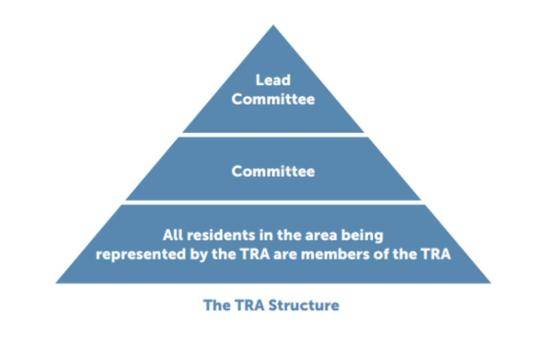A committee is a group of people working together towards common goals, aims and objectives.
The committee will have a mixture of skills, experiences and characters. Different opinions are an important part of discussing ideas and coming to decisions.
The committee is elected for a term of 12 months.
An active committee member:
Attends meetings regularly and arrives on time.
- Makes useful suggestions at meetings.
- Keeps in touch with the committee between meetings.
- Keeps comments short and to the point.
- Listens to others and does not interrupt.
- Supports others to be involved.
- Does what they say they will do.
- Abides by the group's decisions.
- Challenges all forms of discrimination.
- Works as part of the team to get things done.
Lead Committee Members
Lead Committee members are responsible for the running of the TRA. These positions are elected to at the Annual General Meeting (AGM).
Unless the TRA represents street properties, Lead Committee Members must be council housing residents and cannot be residents from housing associations or private households. They have defined roles and responsibilities in their position of Chair, Treasurer, Secretary, or Vice Chair. More details of the roles are set out below:
Residents can join the committee by expressing an interest at the AGM. They can do this by raising their hand following the election of the Lead Committee when a request for committee members is made by the officer running the election.
The Chair:
- Guides the group to achieve its objectives.
- Chairs meetings, ensuring they run smoothly and efficiently.
- Keeps informed about the activities carried out by the group.
- Ensures other committee members are effectively carrying out their responsibilties.
The Treasurer:
- Opens a bank account in the group's name.
- Deposits and records all received funds in the bank.
- Maintains a detailed record of the income and issue receipts.
- Maintains a detailed record of outgoing payments and maintain a record of expenses. Handle day-to-day expenditures through petty cash.
- Keeps committee informed of financial situation at each meeting.
The Secretary:
- Communicates meeting details, including date, time, and agenda, to members.
- Invites external speakers to attend
- Works with the Chair to prepare meeting agendas.
- Takes accurate minutes during meetings.
- Follows up on actions in between meetings
- Handles written correspondence on behalf of the group.
- Keeps members informed about incoming and outgoing correspondence.
The Vice Chair (optional):
- Supports the Chair in guiding the group towards its goals.
- Deputises for the Chair in their absence.
- Works closely with other committee members to facilitate smooth operations.
Planning for the year ahead and working as a team
- The committee should develop a forward plan which will detail the main issues of concern for the members of the association, for example: repairs, crime, vandalism, noise, nuisance etc.
- It is often a good idea for each committee member to take a lead on an area of responsibility. Even if they may not know much about that area at the beginning, it will give each person a focus of things that they can learn about and report on in the committee meetings.
- It is important to involve everyone in the various activities of the association. Community spirit comes from feeling involved and owning or accepting responsibility.
- It is the responsibility of all committee members to ensure that people work together and avoid having one person decide or do everything.
Some examples of activities committee members can undertake include:
- Setting up clubs or regular activities for the community.
- Delivering flyers, letters, or newsletters.
- Putting up posters to advertise meetings.
- Helping to develop a website for the TRA.
- Reporting fly tipping for the neighbourhood.
- Arranging events and activities such as community litter picking.
- Arranging coach trips for residents.
Handover
As a committee member, you may be responsible for holding information about the TRA. This could include financial records, if you are the Treasurer, or contact details if you are the Secretary.
It's important that you keep this information safely and securely and hand this over at the end of your term in the position to the newly elected post holder. Failing to provide this information to the new committee could mean that they are unable to operate correctly, or to access their funds.
Membership
All residents in the area that is represented by the TRA are automatically classed as members of the TRA.
The Lead Committee (Chair, Treasurer, Secretary, Vice Chair) are individually elected to their roles.
Members then have the opportunity to join the committee. By doing so, they are committing to play an active role in the TRA and attend committee meetings outside of the schedule of open meetings for all members.
The diagram below helps to explain the TRA structure:
